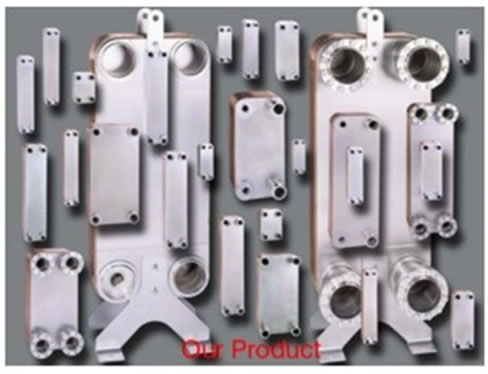Copper brazed plate heat exchangers provide efficient heat transfer with a small footprint. They are maintenance free, provide a long service lifetime and can withstand high temperatures and extremely high design pressures. They are used in a range of duties including cooling, heating, evaporation and condensing.
Flow Principle
The basic flow principle in a brazed heat exchanger for refrgieration applications is parallel or diagonal flow to achieve the most efficient heat transfer process. In a single pass design all connections are located on one side of the heat exchanger, making installation very easy.
Evaporator -Flow Principle
The channels formed between the corrugated plates and corners are arranged so that the two media flow through alternate channels, always in opposite directions (counter current flow).
Condenser -Flow Principle
The main componenets are the same as for the evaporator. The refrigerant enters at top left of the exchanger as hot gas and starts to condense on the surface of the channels until fully condensed, and is then slightly subcooled. The process is call "free condensation".
Chiller
Cools water or brine and rejects the heat to air or water. The water is transported by a hydraulic system through different types of heat exchanger to cool air in an air conditioning system or to cool manufacturing or industrial processes. Two basic systems are normally used to drive chillers: a compressor driven by an electric motor, based on a vapour compression refrigeration cycle; or a heat-driven syste,(steam, burning natural gas), based on an absorption refrigeration cycle.
Heat Pump
A type of water chiller that can also run in a reverse cycle, also called a water-source heat pump. In this case the primary function is heating water and rejecting the cool to air or water. The heated water warms up air in the air conditioning system.
BHEs in refrigeration applications
The BHE is an efficient solution for a range of functions in refrigeration applications. The most common of these involve transferring heat from two basic media: the refrigerant as the primary fluid (HFC or natural gas) and water or brines as the secondary fluid:
- Evaporator, dry expansion, cooling water,
- Condenser, rejecting or recovering heat to water,
- Desuperheater for partial heat recovery to water,
- Economizer, cooling liquid refrigerant and superheating vapour refrigerant.
Other possible functions
- Subcooler to cool down the liquid refrigerant using well water,
- Inermediate heat exchangers used in the absorption cycle to preheat the diluted solution or to pre-cool the concentrated solution.
Advantages
- Compact, durable designs with consistently high quality; ease of installation.
- Extensive range of BHE models providing cooling capacities from 0.5 to 600 kW.
- Equalancer system provides a substantial saving in heat transfer surface compared to BHEs with traditional distribution system.
- Cost efficient: space saving due to the compact design of BHEs compared to shell-and tube heat exchangers.
- Rapid response to temperature changes due to small hold-up volume and lower refrigerant charge.
- Optimized design for every duty with customized BHE congiguration to customer's own specifications.
- All widely recognized pressure vessel codes available as standard.
- Every BHE is pressure and leak tested before delivery, ensuring top quality products.
Fusion-bonded plate heat exchangers (AlfaNova)
Fusion-bonded plate heat exchangers are made of 100% stainless steel and provide efficient heat transfer with a small footprint. They are maintenance free and provide a long service lifetime. They are suited in applications which put high demand on cleanliness, applications where aggressive medias such as ammonia are used or where copper and nickel contamination is not accepted. Can handle very high temperatures or extremely high pressures.
